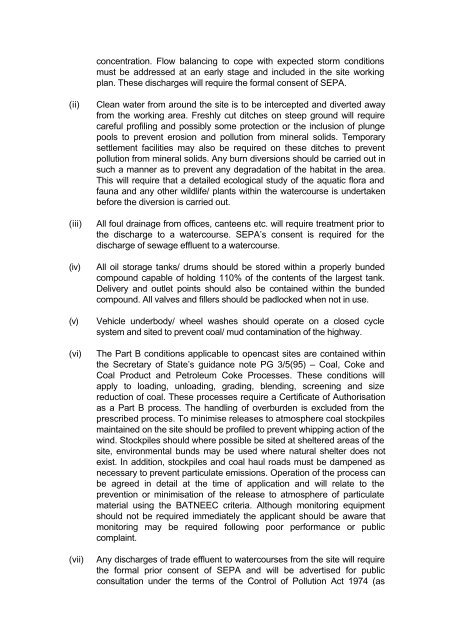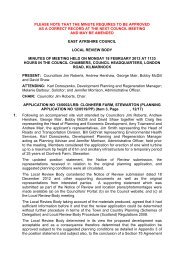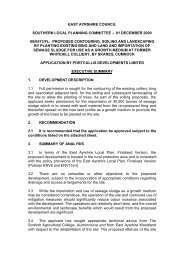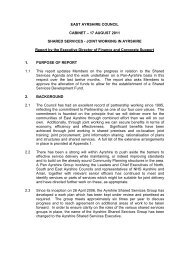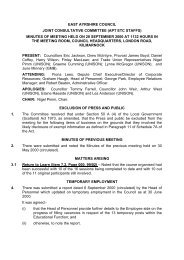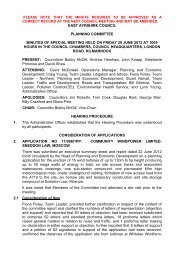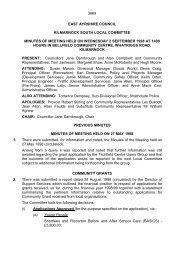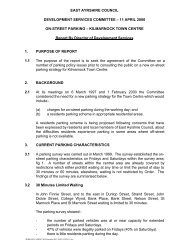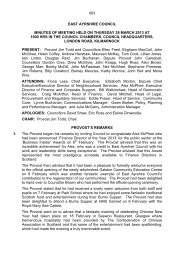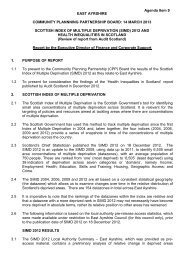Garlaff landfill Site, Skares - Barr Ltd - East Ayrshire Council
Garlaff landfill Site, Skares - Barr Ltd - East Ayrshire Council
Garlaff landfill Site, Skares - Barr Ltd - East Ayrshire Council
You also want an ePaper? Increase the reach of your titles
YUMPU automatically turns print PDFs into web optimized ePapers that Google loves.
concentration. Flow balancing to cope with expected storm conditions<br />
must be addressed at an early stage and included in the site working<br />
plan. These discharges will require the formal consent of SEPA.<br />
(ii)<br />
(iii)<br />
(iv)<br />
(v)<br />
(vi)<br />
(vii)<br />
Clean water from around the site is to be intercepted and diverted away<br />
from the working area. Freshly cut ditches on steep ground will require<br />
careful profiling and possibly some protection or the inclusion of plunge<br />
pools to prevent erosion and pollution from mineral solids. Temporary<br />
settlement facilities may also be required on these ditches to prevent<br />
pollution from mineral solids. Any burn diversions should be carried out in<br />
such a manner as to prevent any degradation of the habitat in the area.<br />
This will require that a detailed ecological study of the aquatic flora and<br />
fauna and any other wildlife/ plants within the watercourse is undertaken<br />
before the diversion is carried out.<br />
All foul drainage from offices, canteens etc. will require treatment prior to<br />
the discharge to a watercourse. SEPA’s consent is required for the<br />
discharge of sewage effluent to a watercourse.<br />
All oil storage tanks/ drums should be stored within a properly bunded<br />
compound capable of holding 110% of the contents of the largest tank.<br />
Delivery and outlet points should also be contained within the bunded<br />
compound. All valves and fillers should be padlocked when not in use.<br />
Vehicle underbody/ wheel washes should operate on a closed cycle<br />
system and sited to prevent coal/ mud contamination of the highway.<br />
The Part B conditions applicable to opencast sites are contained within<br />
the Secretary of State’s guidance note PG 3/5(95) – Coal, Coke and<br />
Coal Product and Petroleum Coke Processes. These conditions will<br />
apply to loading, unloading, grading, blending, screening and size<br />
reduction of coal. These processes require a Certificate of Authorisation<br />
as a Part B process. The handling of overburden is excluded from the<br />
prescribed process. To minimise releases to atmosphere coal stockpiles<br />
maintained on the site should be profiled to prevent whipping action of the<br />
wind. Stockpiles should where possible be sited at sheltered areas of the<br />
site, environmental bunds may be used where natural shelter does not<br />
exist. In addition, stockpiles and coal haul roads must be dampened as<br />
necessary to prevent particulate emissions. Operation of the process can<br />
be agreed in detail at the time of application and will relate to the<br />
prevention or minimisation of the release to atmosphere of particulate<br />
material using the BATNEEC criteria. Although monitoring equipment<br />
should not be required immediately the applicant should be aware that<br />
monitoring may be required following poor performance or public<br />
complaint.<br />
Any discharges of trade effluent to watercourses from the site will require<br />
the formal prior consent of SEPA and will be advertised for public<br />
consultation under the terms of the Control of Pollution Act 1974 (as


